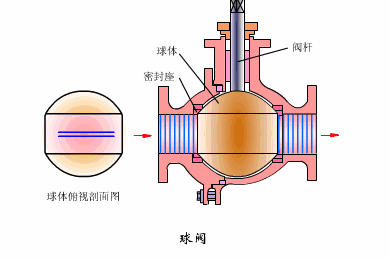+86 15858532562
Views: 34 Author: Site Editor Publish Time: 2024-05-14 Origin: Site








Stainless steel ball valves are fundamental components in modern fluid control systems, renowned for their simplicity, reliability, and excellent sealing capabilities. Their operation revolves around a straightforward yet highly effective mechanism that enables quick shutoff and minimal flow resistance. The use of stainless steel (typically grades 304 or 316) ensures corrosion resistance, durability, and compatibility with a wide range of media, from ultrapure water to aggressive chemicals.
A standard stainless steel ball valve consists of several key elements:
Valve Body: The main housing, typically constructed from ASTM A351 CF8 (304) or CF8M (316) stainless steel, providing structural integrity and corrosion resistance.
Ball: A precision-machined sphere with a through-hole (bore) that rotates to align or misalign with the flow path. The ball surface is often polished to reduce friction and improve sealing.
Stem: A shaft connecting the actuator to the ball, transmitting rotational force to open or close the valve. Stem seals prevent leakage along the shaft.
Seats: Ring-shaped seals (often PTFE, reinforced PTFE, or metal) that form a tight seal against the ball surface. The seat material varies based on temperature and chemical compatibility requirements.
Actuator: A handle, lever, or automated device (pneumatic/electric) that rotates the stem.
The valve operates on a simple quarter-turn (90-degree) principle:
Open Position: The ball rotates until the bore aligns perfectly with the pipeline, creating an unobstructed flow path. In full-bore designs, the bore diameter matches the pipe diameter, minimizing pressure drop.
Closed Position: A 90-degree rotation positions the bore perpendicular to the flow, blocking fluid passage. The seats press firmly against the ball surface, creating a bubble-tight seal.
This simple rotational movement allows for rapid operation—critical in emergency shutoff applications—while the spherical design ensures smooth flow and low turbulence.
The sealing performance depends on two key mechanisms:
Upstream Sealing: System pressure pushes the ball against the downstream seat, enhancing sealing force. This self-energizing feature improves sealing under higher pressures.
Elastic Deformation: Soft seats (e.g., PTFE) deform slightly under compression to fill microscopic imperfections between the ball and seats.
For high-temperature or abrasive services, metal-seated valves employ hardened stainless steel balls and seats, relying on precision machining rather than elastic deformation for sealing.
Full Port vs. Reduced Port: Full port valves have a bore diameter equal to the pipe ID, offering minimal pressure loss. Reduced port valves have a smaller bore, reducing valve size and cost but increasing flow resistance.
Flow Direction: While most ball valves are bidirectional, some specialized designs (e.g., cavity-filled ball valves) may require specific flow directions to prevent debris accumulation.
Low Operating Torque: Minimal friction due to the spherical design reduces the force required for operation.
Rapid Operation: Quarter-turn operation enables faster response compared to multi-turn valves like gate or globe valves.
Excellent Sealing: Soft seats achieve bubble-tight shutoff, with leakage rates as low as Class VI (according to ANSI FCI 70-2).
Minimal Maintenance: The simple design with few moving parts reduces wear and simplifies maintenance.
High-Pressure Capability: Trunnion-mounted designs (with mechanical anchors) handle pressures up to ANSI Class 1500.
Locking Devices: Handles with lockable positions prevent unauthorized operation.
Spring-Loaded Seats: Springs maintain seating force during pressure fluctuations or temperature changes.
Antistatic Design: A spring between the ball and stem prevents static electricity buildup in hydrocarbon services.
Fire-Safe Construction: Secondary metal seals maintain sealing even if soft seats are damaged by fire.
Water Treatment: The quick operation and corrosion resistance make these valves ideal for filter backwashing and flow diversion.
Chemical Processing: The sealed design prevents leakage of hazardous fluids, while stainless steel resists corrosive media.
Oil and Gas: Full-bore valves provide pigging capability in pipelines, while antistatic designs ensure safety.
Pharmaceutical: Polished interiors and crevice-free designs meet sanitary standards for sterile processes.
Food and Beverage: Easy cleaning and full bore design prevent product contamination and allow CIP cleaning.
Conclusion
The working principle of stainless steel ball valves—based on a rotating sphere with a through-bore—represents a perfect balance of simplicity and functionality. This design delivers reliable shutoff, low flow resistance, and operational efficiency across diverse industries. The marriage of this robust mechanical principle with the corrosion-resistant properties of stainless steel ensures longevity and performance in demanding environments. Understanding the interaction between the ball, seats, and stem—along with proper material selection—enables engineers to optimize valve performance for specific applications, from general industrial services to critical safety systems.

Power classification: manual, electric, pneumatic